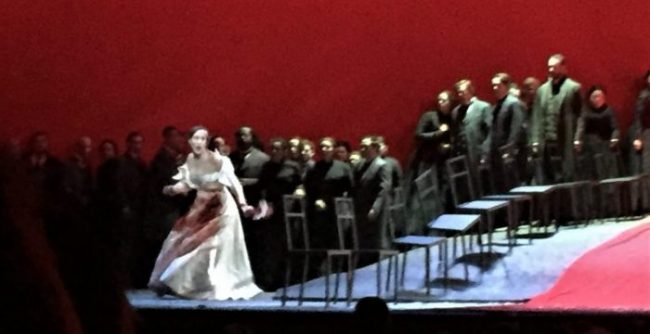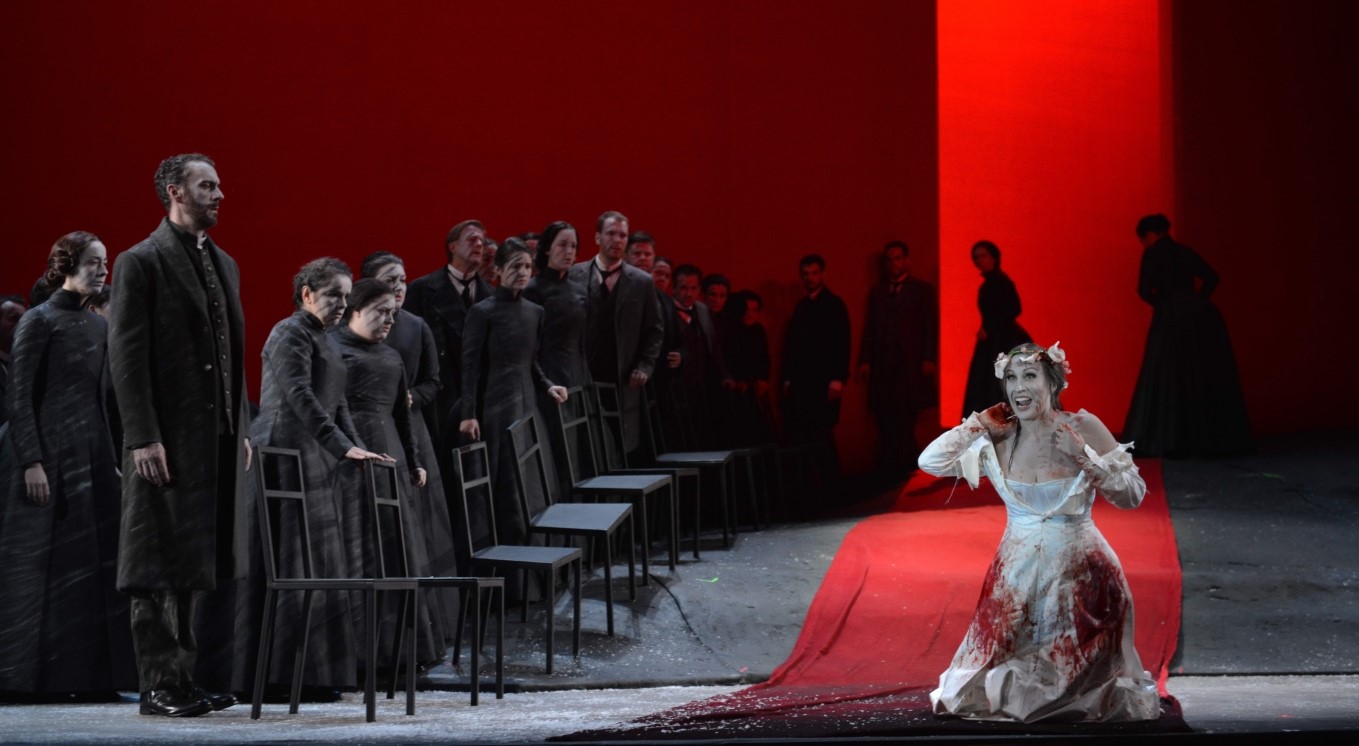
Donizetti: Lucia di Lammermoor. Opera Philadelphia as part of its Festival O18, September 2018.
I’ve enjoyed productions by Laurent Pelly in Santa Fe (La Belle Hélène) and at the Metropolitan Opera (Cendrillon). Therefore I had high expectations for his new Lucia di Lammermoor for Opera Philadelphia. Especially since he promised an innovative look at this opera.
The result is musically excellent but dramatically problematic.
The same conductor (Corrado Rovaris) and two of its stars (Brenda Rae and Christian Van Horn) were in a different production of Lucia in Santa Fe in 2017 that I reviewed here. All of them have improved their performances, and their supporting colleagues are much better here. Rovaris’s pacing is more nuanced, although he still rushes the end of the wedding scene.
Rae and Rovaris have refined some of her vocal embellishments in her first-act “Regnava nel silenzio” and in her mad scene. She sings with a lovely lyric voice and accurate coloratura. Once again they use Donizetti’s first choice of a glass harmonica (instead of a flute) as accompaniment. Fingertips caressing the rims of goblets produces eerie tones that are perfect for the situation. It’s a softer sound, which matches Lucia’s state of mind. (This ethereal instrumentation can be heard on a recording with Beverly Sills, and in a French-language recording by Natalie Dessay.)
Basso Van Horn is a tower of strength as the family chaplain Raimondo. Tenor Michael Spyres is outstanding as Edgardo, with clean singing that avoids needless sobbing. Baritone Troy Cook, as Enrico, sings smoothly but could have been more threatening in the scenes with his sister. Mezzo Hannah Ludwig is a star of the future who is fleetingly seen and heard as Alisa. Lyric tenor Andrew Owens is fine as Arturo. The chorus sounds exceptionally strong under the leadership of Elizabeth Braden.
Pelly’s production is intentionally, and overwhelmingly, bleak. Whether we’re impressed with his originality depends on what we’ve seen in the past. Compared to old-style stagings that treated Lucia as a romantic showpiece, Pelly’s take is welcome. But compared to some recent productions that hewed to the dramatic intentions of Sir Walter Scott, this is a mixed bag.
For instance, in 2014 Nic Muni directed a production for the Academy of Vocal Arts that did stress the machinations of Lucia’s family to force her into a loveless marriage that would further their clan’s fortunes. In Scott’s novel, Lucie Ashton is in love with the nobly born but now dispossessed Edgar Ravenswood. The Ravenswoods and the Ashtons, who now own the former Ravenswood lands, are enemies. In order to save the family from bankruptcy and ruin, Lucie is forced against her will to break her engagement to Edgar and marry the wealthy and politically privileged Sir Arthur Bucklaw. In the opera, those characters are named Lucia, Edgardo, and Arturo.
Muni’s production used dark sets with walls covered by ancestral portraits. His direction reminded us of the family distress and made us realize why Enrico terrorizes his sister. Arturo becomes a villain, taking advantage of the family and disrespecting Lucia; small wonder she stabs him to death on their wedding night.
Pelly displays all that but also presents a Lucia who is hysterical from her opening appearance, fists tightly clenched and lurching around. His opening picture is of a snowy landscape, indicating the desolation and forlornness of the situation. When Lucia slips on the snow and ice, it’s a clever way of indicating how Lucia is slipping and sliding through life, unsure of her footing. But Pelly overdoes this cold approach, just as he does the hysteria of Lucia. Throughout the entire first half of the production – Donizetti’s acts 1 and 2 — all of the scenery is grey and every costume is grey. In the entire evening, the only respite is the mad scene, where the stage is red.
My biggest objection is that the production has no sense of place. That’s damaging when the opera concerns the properties of feuding families. There’s no suggestion of the hills of Scotland. We see only an outline of the outside of a family mansion. We never see an interior, not even during the wedding party which takes place in “The grand hall of the castle” according to the libretto. When Lucia and her brother argue, they stand outside in the snow although they wear indoor clothing. When Lucia sings about seeing red blood flowing in a fountain, there’s no fountain. In Edgardo’s famous Tomb Scene, where he sings about his family’s graves, there’s nary a single tombstone nor crypt.
When the wedding celebration begins, the guests sing that they’re jubilant (“Per te d’immenso giubilo”) but they trudge across the stage as if they are at a funeral, which doesn’t match the music. Pelly meant for us to see the opera from Lucia’s perspective, but that lacks logic because much of the action takes place outside of her observation or knowledge. So, the conception is clever, but flawed.
One example of Pelly’s approach illustrates a vital point. In the middle of the love duet between Lucia and Edgardo, he walks off to our right, only to reappear a minute later in different garb re-entering the stage from our left, to sing the rest of their duet. So Pelly makes him a figment of her imagination, but audience members at intermission were confused. What was the purpose? Clarity should be more important than cleverness.
This production travels to the Vienna State Opera next year.
A shorter version of this review was on the international website The Opera Critic.
